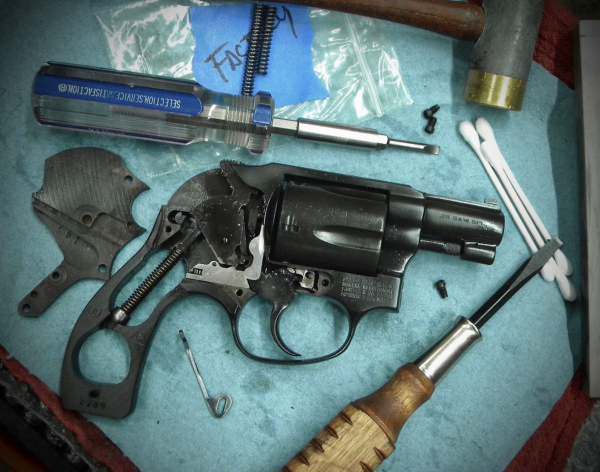
Shooting revolvers is challenging, especially considering all defensive work is done double-action. You may fire in single action to check zero – although I don’t recommend it. For self-defense you never cock the hammer to shoot single action; they are not made to be de-cocked, especially under stressful conditions. The problem is that most revolvers have very stiff triggers, plus they’re usually a little crunchy. But there is a cure: Get a tune-up.
Transforming a revolver’s trigger into a smooth action with a crisp break is a lot more involved than just swapping out springs. There’s no huge gain achieved by just doing a couple of modifications. Sure, you can replace a couple of springs – the main/hammer spring and the rebound spring, which resets the trigger – but that will only give you a slight gain, and do nothing to smooth out the action.
A true “trigger job” involves reworking pretty much every internal component, and there are plenty of them. Anywhere you have metal on metal friction gets honed or polished. Some springs are replaced – the main/hammer spring and rebound spring mentioned above – a couple are shortened and some are left as is, as long as they are functioning. Eventually all of these small reductions add up to a significant improvement.
The end result is a nice, smooth trigger action with a crisp break. It’s the difference you’d feel between running your hand across a coarse piece of sandpaper vs. a piece of glass that’s covered in soapy water. “Slick” is a good adjective to describe the experience.
Can you do this yourself? Sure, but only after a lot of studying the “how,” and then plenty of practice. There’s plenty of material on action jobs to review; as always be sure of the source. Jerry Miculek has some great videos. I highly recommend Jerry Kuhnhausen’s shop manual on S&W revolvers. There are also a few specialty tools required. The quickest way to ruin a good revolver is to use the wrong size/type screwdriver. The correct tools will let you remove and replace springs, or remove the extractor from the cylinder.
Once you have the know-how and tools it’s time to practice. I started my education on a gun shop “rescue.” The finish was rough – didn’t care – but the internals were in good shape. Over the next year I’d spend an hour or so a week doing a trigger job. I bet that Model 10 was taken apart and reassembled over a hundred times.
The J frame pictured above started out with a trigger past what my gauge will register – twelve pounds. It was also rough, with about four spots where you could feel it hitch, then jump past to the next. It was a “hard” trigger to shoot accurately. Yes, you could do it, but only with intense focus on what you were doing. After tuning the weight dropped down to nine and one-half pounds. (You can get a lighter trigger, but may not get constant ignition with some ammunition.). It’s a smooth action from start to finish, and the break is crisp. “Tuning” may also include swapping out stocks – “grips” – sights or modifications like bobbing the hammer spur.
If you’ve never fired a revolver that has been “fixed” you’ll be surprised at the benefits. You can take a handgun that’s difficult to fire accurately and feels good in hand to something that’s a true joy to fire, and hits about anything you aim it at.
It’s not a job for amateurs: unless you’ve got lots of revolvers to tune, your best bet is to get a professional to do the job. Dig one of those old wheel-guns out of the safe and get it tuned. You won’t be disappointed.
Tiger McKee is director of Shootrite Firearms Academy, which is celebrating its twenty-fifth anniversary. He is the author of The Book of Two Guns, AR-15 Skills and Drills, has a regular column in American Handgunner and makes some cool knives and custom revolvers. Visit Shootrite’s Facebook page for other details.
